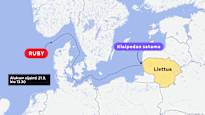The situation of the damaged MV Ruby is difficult. The professor of maritime law believes that Denmark’s decision to help the vessel is a step to resolve the situation.
Pyry Dementjeff,
Kaisa Uusitalo
The cargo of the damaged cargo ship MV Ruby complicates the ship’s situation.
The cargo of the ship that received help from Denmark is approximately 20,000 tons of ammonium nitrate. The substance is used as a fertilizer in agriculture, but it can also explode destructively.
Transport director of Haminan-Kotka port, Finland’s largest fertilizer port Timo Rosendahl says that no ship carrying the substance can enter the port due to the security risk.
– The answer is unequivocally no. Since ammonium nitrate has the dangerous properties it does, it is not processed in the port of Haminan-Kotka and must not be on the ship.
The port of Haminan-Kotka issued a policy on the matter in 2020 after 2,750 tons of the same fertilizer caused an explosion in Beirut, Lebanon.
Åbo Akademi’s professor of maritime law Henrik Ringbom states can deny ships access to their ports.
Currently, MV Ruby’s destination is Lithuania. The country has said that the ship can only be repaired if it unloads its cargo elsewhere before arriving at the port. Also, the line of the Norwegian authorities has been for several weeks that the vessel will not be allowed into Norwegian ports.
The ship’s cargo is normal
Despite the risks, the ship’s cargo is by no means exceptional.
According to Rosendahl of Hamina-Kotka port, ammonium nitrate is a commonly used fertilizer in agriculture. According to Professor Ringbom, it is often transported by sea.
The size of the ship’s cargo is also normal. According to Rosendahl, the product is relatively cheap. When the distances are long, large loads are a cost-effective option.
Professor of inorganic material chemistry at the University of Helsinki Mikko Ritala on the other hand, says that ammonium nitrate intended for fertilizer use is stabilized, i.e. modified in such a way that it would not explode by itself. According to Ritala, the substance is dangerous, but she does not consider the ship’s cargo particularly dangerous.
– If the ship is loaded with fertilizer ammonium nitrate, then I wouldn’t be worried if the ship didn’t catch fire.
A step in the right direction
Denmark decided over the weekend to let the ship pass through its straits with the help of a Danish pilot. Professor Ringbom sees that Denmark’s decision to let the ship into the Baltic Sea is a step in the right direction to solve the situation.
– It means that the Danish authorities have come to the conclusion that the ship with its cargo does not pose such a high risk that it cannot be allowed through.
According to Ringbom, the ship must reach a place where the cargo could be safely removed. After this, the ship could continue its journey to the repair yard. Alternatively, cargo unloading and repair could also be done in the same place.
In addition to the potential risk of the cargo, the country of origin of the cargo, Russia, also affects the matter.
– Maybe this also has its own effect on people thinking about whether to let the ship into the port in the first place.
However, Denmark’s decision to allow the ship to pass through shows that the country does not consider the risk too great.
– As far as I understand, Denmark sees it as quite ordinary transport.
Although the ship’s progress through the Danish straits is a good thing, it still needs to be decided where the ship will continue after that. According to Ringbom, an alternative could be for the ship to first unload the cargo in another port and then head to the repair port in Lithuania.
– One option is, of course, Kaliningrad, which is in the same country where the cargo originally came from.
